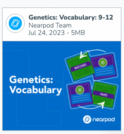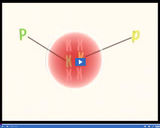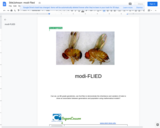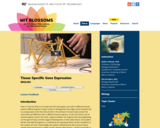
34 Results


When a parent plant forms sex cells, the genes of the parent separate. According to the Law of Segregation a gene from each pair goes to each sex cell.
- Subject:
- Science
- Provider:
- Utah Education Network
- Author:
- Visual Learning Company
- Date Added:
- 02/28/2010

The Genetics Student Edition book is one of ten volumes making up the Human Biology curriculum, an interdisciplinary and inquiry-based approach to the study of life science.
- Subject:
- Biology
- Science
- Material Type:
- Activity/Lab
- Textbook
- Provider:
- CK-12 Foundation
- Provider Set:
- CK-12 FlexBook
- Author:
- Program in Human Biology, Stanford University
- Date Added:
- 02/04/2011

In this video segment adapted from NOVA: Judgment Day: Intelligent Design on Trial, learn how modern genetics and molecular biology offer compelling support for evolution. The video features an interview with biologist Ken Miller.
- Subject:
- Anthropology
- Biology
- Science
- Material Type:
- Lecture
- Provider:
- PBS LearningMedia
- Provider Set:
- PBS Learning Media: Multimedia Resources for the Classroom and Professional Development
- Date Added:
- 11/01/2007

Students will breed fruit flies through several generations and record their data using mathematical models in order to demonstrate the inheritance of trait variations.
- Subject:
- Science
- Material Type:
- Unit of Study
- Provider:
- Lane County STEM Hub
- Provider Set:
- Content in Context SuperLessons
- Author:
- Courtney Stitt
- Jessica Johnson
- Date Added:
- 12/10/2020

Discover what controls how fast tiny molecular motors in our body pull through a single strand of DNA. How hard can the motor pull in a tug of war with the optical tweezers? Discover what helps it pull harder. Do all molecular motors behave the same?
- Subject:
- Biology
- Science
- Material Type:
- Simulation
- Provider:
- University of Colorado Boulder
- Provider Set:
- PhET Interactive Simulations
- Author:
- Chris Malley
- Kathy Perkins
- Meredith Betterton
- Michael Dubson
- Thomas Perkins
- Wendy Adams
- Date Added:
- 12/01/2007

Explore natural selection by controlling the environment and causing mutations in bunnies.
- Subject:
- Biology
- Science
- Material Type:
- Simulation
- Provider:
- University of Colorado Boulder
- Provider Set:
- PhET Interactive Simulations
- Author:
- Jonathan Olson
- Noah Podolefsky
- Wendy Adams
- Date Added:
- 04/01/2009

Watch how NJ high school students apply basic principles of molecular biology to solve real research problems, and publish their own genome research at GenBank, the international genomic sequence database.
- Subject:
- Biology
- Science
- Material Type:
- Lecture
- Provider:
- PBS LearningMedia
- Provider Set:
- Teachers' Domain
- Date Added:
- 05/08/2009

In this video segment adapted from NOVA scienceNOW, learn about RNAi's potential to treat a wide range of genetic and infectious diseases.
- Subject:
- Biology
- Engineering
- Science
- Material Type:
- Lecture
- Provider:
- PBS LearningMedia
- Provider Set:
- PBS Learning Media: Multimedia Resources for the Classroom and Professional Development
- Date Added:
- 08/09/2007

This video segment from Kentucky Life describes how scientists control pollination of one of the few remaining American chestnut trees to develop blight resistant trees.
- Subject:
- Agriculture Education
- Biology
- Career and Technical Education
- Engineering
- Science
- Material Type:
- Lecture
- Provider:
- PBS LearningMedia
- Provider Set:
- Teachers' Domain
- Date Added:
- 08/25/2008

How is it that all cells in our body have the same genes, yet cells in different tissues express different genes? A basic notion in biology that most high school students fail to conceptualize is the fact that all cells in the animal or human body contain the same DNA, yet different cells in different tissues express, on the one hand, a set of common genes, and on the other, express another set of genes that vary depending on the type of tissue and the stage of development. In this video lesson, the student will be reminded that genes in a cell/tissue are expressed when certain conditions in the nucleus are met. Interestingly, the system utilized by the cell to ensure tissue specific gene expression is rather simple. Among other factors - all discussed fully in the lesson - the cells make use of a tiny scaffold known as the “Nuclear Matrix or Nucleo-Skeleton”. This video lesson spans 20 minutes and provides 5 exercises for students to work out in groups and in consultation with their classroom teacher. The entire duration of the video demonstration and exercises should take about 45-50 minutes, or equivalent to one classroom session. There are no supplies needed for students’ participation in the provided exercises. They will only need their notebooks and pens. However, the teacher may wish to emulate the demonstrations used in the video lesson by the presenter and in this case simple material can be used as those used in the video. These include play dough, pencils, rubber bands (to construct the nuclear matrix model), a tennis ball and 2-3 Meters worth of shoe laces. The students should be aware of basic information about DNA folding in the nucleus, DNA replication, gene transcription, translation and protein synthesis.
- Subject:
- Biology
- Science
- Material Type:
- Lecture
- Provider:
- M.I.T.
- Provider Set:
- MIT Blossoms
- Author:
- Rabih Talhouk, Elia El-Habre
- Date Added:
- 12/10/2020

Understanding Biodiversity presents an overview of biodiversity, its importance and relevance to humans, all living things, and the Earth. It includes species pages and a template to engage and involve students in real-life data collection.
- Subject:
- Biology
- Science
- Material Type:
- Activity/Lab
- Homework/Assignment
- Lesson Plan
- Reading
- Textbook
- Provider:
- CK-12 Foundation
- Provider Set:
- CK-12 FlexBook
- Author:
- Douglas Wilkin Ph.D.
- Date Added:
- 10/24/2011

it would be ideal if students already have learned that DNA is the genetic material, and that DNA is made up of As, Ts, Gs, and Cs. It also would help if students already know that each human has two versions of every piece of DNA in their genome, one from mom and one from dad. The lesson will take about one class period, with roughly 30 minutes of footage and 30 minutes of activities.
- Subject:
- Biology
- Science
- Material Type:
- Lecture
- Provider:
- M.I.T.
- Provider Set:
- MIT Blossoms
- Author:
- Megan E. Rokop
- Date Added:
- 12/10/2020

This lesson introduces students to the concepts of evolution, specifically the evolution of humans. So often our students assume that humans are well adapted to our environments because we are in control of our evolutionary destiny. The goal is to change these types of misconceptions and get our students to link the concepts learned in their DNA, protein synthesis, and genetics units to their understanding of evolution. Students will also discover that humans are still evolving and learn about the traits that are more recent adaptations to our environment. The lesson is designed to take two one-hour class periods to complete. The activities will allow students to draw connections between environmental pressures and selected traits, both through data analysis and modeling. Most activities can be done without any special materials, although the Modeling Natural Selection activity needs either a tri-colored pasta, or tricolored beans, to be completed effectively.
- Subject:
- Biology
- Science
- Material Type:
- Lecture
- Provider:
- M.I.T.
- Provider Set:
- MIT Blossoms
- Author:
- Julie Boehm
- Date Added:
- 12/10/2020